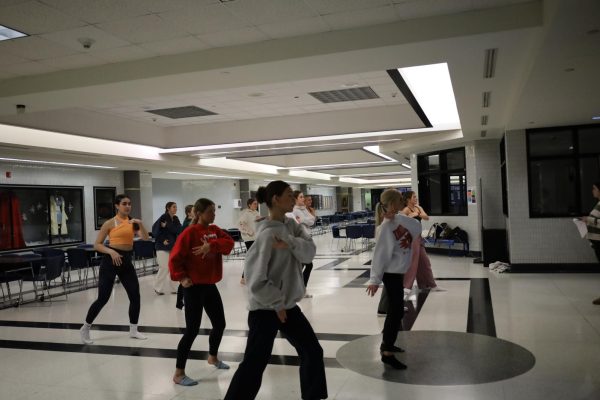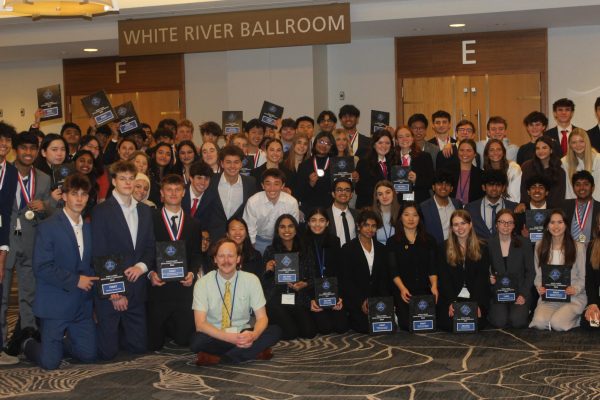Rapping Up Music Genres
Students and a music professor discuss how the emergence of rap music affects society and music’s past and future.
More in Online Online:

Sophomore Gracie Gilbert, pictured, believes rap music appeal is growing, causing a difference in perspective for high school and college students. “With so many more teens listening to rap music, their behavior and actions can be easily effected just because of the influence the music genre has,” Gilbert said.
With the scheduled release of many new songs and albums by a variety of artists, such as Drake, Kendrick Lamar, Kanye West and more, the history of music and the history of rap is taken into consideration by those opening up their ears and minds to it.
Kyle Adams, associate professor of (music theory) and chairperson of the department of music theory at Indiana University, said he grew up with different genres music, and that the appeal rap music holds has grown since the 20th and early 21st century.
“Hip-hop started in the late 1970s and early 1980s, and at first it really only appealed to inner-city youth,” Adams said via email. In the present year, it is understood that rap music generally appeals to high school and college students, as it promotes different aspects of life that country, classic rock, jazz or pop music might not demonstrate.
Sophomore Emma Wirth has observed the emergence of rap music and has voiced her opinion on the subject, in regards to her thoughts on how the school social scene has and is changing.
“Many people in this school will go to events or parties or some type of social gathering and rap music will be the music playing. It’s different because people can go from Ed Sheeran to Post Malone or any other rap artist just like that,” Wirth said. “It seems to be the main genre of music nowadays.”
Studies conducted by the Stanford University in August 2007, state the tone of music affects your mood and can influence behaviors, while causing you to perceive the world in different ways. Many different styles of songs depict the type of people who wrote the music and the audience it appeals to.
According to a 2015 presentation by Shaianne Foltz, since the 1980s, music has gone from upbeat and impactful in certain aspects, to vulgar language and a less impactful message hidden in them.
“25 years ago, there was a lot of socially conscious rap, but now all of that is underground. Still, there are many rappers who deal with important social and political themes: the struggles of being young and black in America, the difficulty of being poor or topics about black history. Mainstream rap, unfortunately, has returned to the topics of guns, sex and money that were popular in the early 1980s,” Adams said.
The idea of how rap music has changed can also influence its listeners, in the sense of the social circles they run in.
“There are certain groups of people at school that listen to certain music,” sophomore Gracie Gilbert said. “The type of music you listen to says a lot about your personality and who you are.” Gilbert said she believes that many people are taken aback by the music but fall into the trends due to the fact many students enjoy this music genre.
Being an active social media user, Gilbert said she has come to notice different social situations, most of which can be tied to rap music and the effects it has that are now coming into light.
Although rap and hip-hop music can display a negative look on the genre itself, not all rap can be taken as “negative” or “ inappropriate.”
“I wish a broader audience would give hip-hop music a chance. There’s so much amazing wordplay and rhythm in the music, and I feel like the few terrible artists that get played on the radio (like Migos) basically ruined the public perception of the genre,” Adams said. As rap and hip-hop music emerged in recent years, teens have shown a new type of persona unlike Adams’ generation, where rap music originally emerged, not projecting the same message as it does now.
“I love so many types of music, but I feel rap music is escalating and eliminating the appeal of other music, not like it used to,” Gilbert said. “I used to listen to older bands, but now looking back nobody really listens to them anymore.”
Pusha T, also known as “King Push,” has broken many rap expectations as his upcoming 2018 album is projected to be the “album of the year,” according to himself and his team. The release date is yet to be revealed. This self-declared title beats out artists also releasing music, such as the 1985 rock band Cowboy Junkies, which is scheduled to be released in February of next year. Despite their upcoming releases, many less-anticipated bands, like Cowboy Junkies, appear to not interest to young people.
In the 2017, many rap prodigies such as Wiz-Khalifa, Jaden Smith, Gucci Mane and Kodak Black also released music, taking the high school and college students by storm and immediately landing a spot on their playlists.
“There are many pop singers too that people love, but now more rap artists are collaborating with them so the song also includes a rap portion,” Wirth said. Taylor Swift herself has sang with many artists, including T-Pain and B.o.B. Swift, as many musicians have, has also sang with other rappers or sang their music herself.
According to Adams, the rap artists attract a certain type of audience. “In many cases young white “frat-boy” types, sadly. Also, middle aged whites like me, who grew up during hip-hop’s golden age.”
In a world filled with new music emerging generation by generation, rap music has made its way to the top of the charts, growing in popularity each day. The projection of this music genre has influenced teens, eliminating the appeal of other types of music present today, causing a difference in social scenes, typically among high school and college students. The words and message projected in this music genre has affected teens growing up to this music, as it grows each and every day.
Your donation will support the student journalists of Carmel High School - IN. Your contribution will allow us to purchase equipment and cover our annual website hosting costs.































![British royalty are American celebrities [opinion]](https://hilite.org/wp-content/uploads/2024/03/Screenshot-2024-03-24-1.44.57-PM.png)




















![Review: “The Iron Claw” cannot get enough praise [MUSE]](https://hilite.org/wp-content/uploads/2024/04/unnamed.png)
![Review: “The Bear” sets an unbelievably high bar for future comedy shows [MUSE]](https://hilite.org/wp-content/uploads/2024/03/unnamed.png)
![Review: “Mysterious Lotus Casebook” is an amazing historical Chinese drama [MUSE]](https://hilite.org/wp-content/uploads/2024/03/0.webp)
![Thea Bendaly on her Instagram-run crochet shop [Biz Buzz]](https://hilite.org/wp-content/uploads/2024/03/IMG_0165-1200x838.jpg)
![Review: Sally Rooney’s “Normal People,” is the best book to read when you are in a time of change [MUSE]](https://hilite.org/wp-content/uploads/2024/03/20047217-low_res-normal-people.webp)
![Review in Print: Maripaz Villar brings a delightfully unique style to the world of WEBTOON [MUSE]](https://hilite.org/wp-content/uploads/2023/12/maripazcover-1200x960.jpg)
![Review: “The Sword of Kaigen” is a masterpiece [MUSE]](https://hilite.org/wp-content/uploads/2023/11/Screenshot-2023-11-26-201051.png)
![Review: Gateron Oil Kings, great linear switches, okay price [MUSE]](https://hilite.org/wp-content/uploads/2023/11/Screenshot-2023-11-26-200553.png)
![Review: “A Haunting in Venice” is a significant improvement from other Agatha Christie adaptations [MUSE]](https://hilite.org/wp-content/uploads/2023/11/e7ee2938a6d422669771bce6d8088521.jpg)
![Review: A Thanksgiving story from elementary school, still just as interesting [MUSE]](https://hilite.org/wp-content/uploads/2023/11/Screenshot-2023-11-26-195514-987x1200.png)
![Review: When I Fly Towards You, cute, uplifting youth drama [MUSE]](https://hilite.org/wp-content/uploads/2023/09/When-I-Fly-Towards-You-Chinese-drama.png)
![Postcards from Muse: Hawaii Travel Diary [MUSE]](https://hilite.org/wp-content/uploads/2023/09/My-project-1-1200x1200.jpg)
![Review: Ladybug & Cat Noir: The Movie, departure from original show [MUSE]](https://hilite.org/wp-content/uploads/2023/09/Ladybug__Cat_Noir_-_The_Movie_poster.jpg)
![Review in Print: Hidden Love is the cute, uplifting drama everyone needs [MUSE]](https://hilite.org/wp-content/uploads/2023/09/hiddenlovecover-e1693597208225-1030x1200.png)
![Review in Print: Heartstopper is the heartwarming queer romance we all need [MUSE]](https://hilite.org/wp-content/uploads/2023/08/museheartstoppercover-1200x654.png)


























![Joseph Broman, Mu Alpha Theta sponsor, grades tests for his honors precalculus/trigonometry class. Broman said, “I’m retiring from the Math Club next year and I’m just going to do Mu Alpha Theta so I can focus on that one and we can do more [speaker series] first semester.”](https://hilite.org/wp-content/uploads/2024/03/IMG_9502-600x450.jpg)
